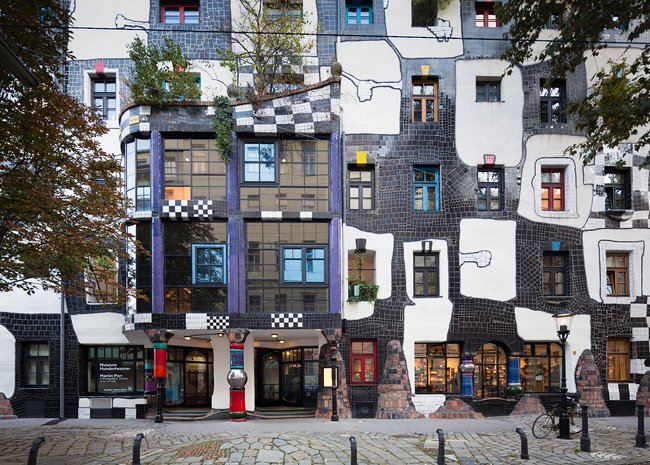History & Architecture
KUNST HAUS WIEN is a house of beauty barriers, where beauty holds the most efficient function, a place of not regulated irregularities, of uneven floors, of tree tenants and dancing windows. It is a house in which you have a good conscience towards nature.
It is a house that does not follow the usual standards, an adventure of modern times, a journey into a country of creative architecture.
Friedensreich Hundertwasser, 1991
Friedensreich Hundertwasser considered the architecture of KunstHausWien “a stronghold against the false order of the straight line, a bastion against the grid system and the chaos of nonsense.” Together with the architect Peter Pelinka he designed a five-storey museum – a fusion of old and new, preserving as many elements as possible – in the former Thonet furniture factory located near the Danube Canal. In addition to some 1,500 square metres of exhibition space they also provided room for a museum shop and a spacious café. The apartment on the top floor was used by Hundertwasser for living and working – a refuge with a wooded roof terrace reminding of Hundertwasser’s ship “Regentag”. KunstHausWien was opened in 1991 after a construction period of two years. The artist’s credo “Art must show its true colours again. Art must address the people again (…) Art must embrace nature and her laws and man and his striving for true and lasting values”, written down as a foundation document, was placed inside the stump of a pillar.
The Third Skin in the Third District
Man is surrounded by three layers, his skin, his clothing and walls, the building.
Clothing and the walls of buildings have in recent times undergone a development which is no longer in keeping with the individual's natural requirements. The outer walls of our modern buildings are our prison walls, for they are anonymous, without emotions, aggressive, heartless, cold and yawningly empty.
My irregular outside design is to be looked on as a precursor to the window right of every individual. The facade is not perfectly straight and flat, but humpy and interrupted by irregular mosaics. A black-and-white, irregular checkerboard pattern signals the disbanding of the grid system, its break-up.
What we urgently need are barriers of beauty; these barriers of beauty consist of uncontrolled irregularities.
Hundertwasser 1985/1991
Window Dictatorship and Window Right
Some people say houses consist of walls. I say houses consist of windows.
The repetition of identical windows next to each other and above each other as in a grid system is a characteristic of concentration camps.
Windows in rank and file are sad, windows should be able to dance.
A person in a rented apartment must be able to lean out of his window and scrape off the masonry within arm's reach. And he must be allowed to take a long brush and paint everything outside within arm's reach, so that it will be visible from afar to everyone in the street that someone lives there who is different from the imprisoned, enslaved, standardised man who lives next door.
Hundertwasser, 1990
Tree Tenants Are the Ambassadors of the Free Forests in the City
Ten tree tenants grow out of the windows of the KunstHausWien.
Tree tenants can be seen from far away and benefit many people, especially those who walk around the house and dwell nearby. The tree tenant symbolizes a turn in human history because he regains his rank as an important partner of man. [...]
We suffocate in our cities through poison and lack of oxygen. We destroy systematically the vegetation which gives us life and lets us breathe. We walk alongside grey and sterile facades of houses.
It is our duty to reinstall the rights of nature with all means.
We suffer daily from the aggressivity and the tyranny of our vertical sterile high walls. But streets in the cities will become green valleys where man can breathe freely again. [...]
The tree tenant is a giver. It is a piece of nature, a piece of homeland, a piece of spontaneous vegetation in the anonymous and sterile city desert, a piece of nature which can develop without the rationalist control of man and his technology.
Hundertwasser, 1991
The Uneven Floor
The flat floor is an invention of the architects. It fits engines ̵ not human beings.
People not only have eyes to enjoy the beauty they see and ears to hear melodies and noses to smell nice scents. People also have a sense of touch in their hands and feet.
An uneven and animated floor is the recovery of man's mental equilibrium,of the diginity of man which has been violated in our levelling, unnatural and hostile urban grid system.
The uneven floor becomes a symphony, a melody for the feet and brings back natural vibrations to man.
It is good to walk on uneven floors and regain our human balance.
Architecture should elevate and not subdue man.
Hundertwasser, 1991








